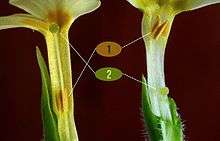Adnation

The tropical pitcher plant Nepenthes adnata is named for its adnate leaf bases
Adnation in plants is the "union of unlike parts; organically united or fused with another dissimilar part, e.g. stamens to petals".[1] This is in contrast to connation, the fusion of similar organs.[2][3]

The stamens of Primula vulgaris are adnate to the corolla
References
- ↑ Little, R. John; Jones, C. Eugene, eds. (1980). A Dictionary of Botany. New York: Van Nostrand Reinhold Company. p. 9. ISBN 0-442-24169-0.
- ↑ Little, R. John; Jones, C. Eugene, eds. (1980). A Dictionary of Botany. New York: Van Nostrand Reinhold Company. p. 91. ISBN 0-442-24169-0.
- ↑ Jackson, Benjamin Daydon (1928). A Glossary of Botanic Terms with their Derivation and Accent (fourth ed.). London: Gerald Duckworth & Co. Ltd. p. 89.
This article is issued from Wikipedia - version of the 7/26/2016. The text is available under the Creative Commons Attribution/Share Alike but additional terms may apply for the media files.